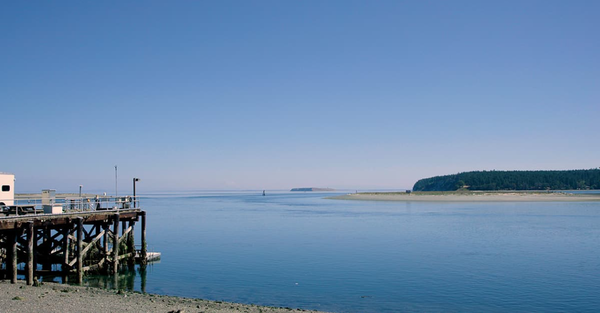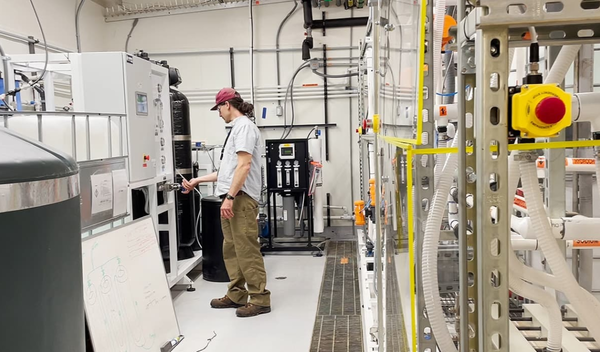[미국] Ebb 탄소, ‘해양 탄소 제거 솔루션’ 태평양 북서부 국립연구소서 가동

PNNL 실험실에서 바라본 세큄 만의 모습 [사진출처(Photo source) = Ebb Carbon]
Ebb 탄소(Ebb Carbon)는 지역적으로 해양 산성화를 줄이는 동시에, 대기중 수십억 톤의 CO₂(이산화탄소)를 제거하기 위해, 전기화학 기술을 사용한 ‘해양 이산화탄소 제거(CDR) 시스템’을 개발했다.
Ebb 탄소는 세큄에 위치한 미국 에너지부(DOE) 산하 태평양 북서부 국립연구소(Pacific Northwest National Lab, PNNL)에서 100톤 규모의 해양 CDR 시스템을 운영하고 있다.
또한, PNNL, 국립해양대기청(National Oceanic and Atmospheric Administration, NOAA), NOAA의 태평양 해양 환경 연구소(PMEL), 워싱턴 대학교의 기후·해양 및 생태계 연구를 위한 협력 연구소(CICOES), 솔리시 해양 모델링 센터(Salish Sea Modeling Center, SSMC)의 해양 건강·모델링·생물 지구 화학 분야 전문가들과 협력하고 있다.

PNNL 연구실 내부 Ebb 시스템의 모습 [사진출처(Photo source) = Ebb Carbon]
해양 이산화탄소 제거를 위한 과학적 기반 구축
Ebb는 세큄에 있는 PNNL 해양 연구소에서 향후 2년 동안 선적 컨테이너 크기의 CDR 시스템을 운영할 예정이다. Ebb의 기술은 전기 화학 기술을 사용해 바닷물을 산성 및 알칼리성으로 분리한다. Ebb의 시스템은 세큄 만(Sequim Bay)에서 끌어올린 바닷물을 일련의 막을 통과시켜 처리한다. 이 막은 필터처럼 작동해 물에서 산을 제거한다. 산이 제거되면 바닷물은 공기에서 추가적인 CO₂를 흡수해, 바닷물을 산성화하지 않는, 자연적으로 풍부한 형태의 중탄산염으로 저장한다.
Ebb는 과학적 협력자들과 함께 공정의 결과로 공기에서 얼마나 많은 CO₂가 제거되는지 측정한다. 또한, 모델링 실험을 진행한다. 이를 위해 해양 모델링 도구를 개발 중이다. 과학자들은 가상 실험을 통해 Ebb의 프로세스가 탄소를 포획 및 저장하고, 해양 산성화를 지역적으로 완화하는 데 어떻게 도움이 되는지 이해한다. 또 연어의 중요한 식량원인 굴과 뱀장어풀 에피파나와 같은 지역 해양 생물학에 미치는 영향을 이해하기 위해 실험을 수행한다.
이 연구 결과는 해양 CDR 분야를 발전시키고, Ebb의 기후 솔루션에 대한 인식과 이해를 높일뿐만 아니라 Ebb의 해양 CDR 솔루션에 대한 엄격한 측정, 보고 및 검증(MRV) 방법론의 토대를 마련하는 데 도움이 될 예정이다.
태양광 산업과의 유사성…신뢰 구축이 기술 발전 가속화
오늘날 해양 이산화탄소 제거 산업과 2000년대 초반의 태양광 산업은 유사한 형태를 보인다. 태양광 산업의 초창기와 마찬가지로, 해양 CDR은 이 기술에 대한 신뢰와 수용을 구축할 데이터를 수집하고, 분석할 전문 과학 검증자가 필요했다.
태양광은 주류 기술이 아니었기 때문에 50년의 역사에도 불구하고 업계는 21세기까지 광범위한 신뢰와 채택을 구축하지 못했다. 이 문제를 해결한 것은 투자였다.
태양광 산업은 국립 재생 에너지 연구소(NREL)의 전문가들과 협력해 데이터를 수집하고, 해당 데이터를 공유해 과학자, 투자자 및 에너지 소비자 간의 이해 격차를 해소하는 데 시간이 걸렸다. 투명성과 신뢰를 높이기 위한 모든 노력이 오늘날 우리가 알고 있는 태양광 산업의 토대를 구축했다. 2020년 말까지 미국에는 약 270만 개의 가정용 태양광 시스템이 있었다.
Ebb의 기후 솔루션 발전 위해 타 기관과 협력
Ebb는 첫 번째 CO₂를 올바른 방법으로 제거하면 미래에 수십억 톤의 CO₂ 제거가 가속화될 수 있다는 것을 알고 있기 때문에 기후 솔루션을 발전시키기 위해 타 기관 및 전문가들과 협력하고 있다. 국립 연구소 및 학계 파트너와 협력해 기술을 안전하고 효과적으로 배포할 토대를 구축할 전망이다.
[원문보기]
Full steam ahead: Ebb’s ocean carbon removal solution is up and running at PNNL-Sequim
At Ebb Carbon, our goal is to remove billions of tons of carbon dioxide from the air while locally reducing ocean acidification. To accomplish this, we have developed an ocean carbon dioxide removal (CDR) system that takes a proven electrochemical technology and applies it to the defining challenge of our time: climate change.
Today, I’m proud to share that Ebb Carbon is operating our first 100 ton ocean CDR system at the DOE’s only marine lab, Pacific Northwest National Lab (PNNL)-Sequim. We are fortunate to work alongside world-leading experts in ocean health, modeling and biogeochemistry from PNNL, the National Oceanic and Atmospheric Administration (NOAA), NOAA’s Pacific Marine Environmental Laboratory (PMEL), and the University of Washington’s Cooperative Institute for Climate, Ocean and Ecosystem Studies (CICOES) and the Salish Sea Modeling Center (SSMC).
Building the scientific foundations for ocean carbon dioxide removal
Ebb will operate our system, which is roughly the size of a shipping container, at PNNL-Sequim’s marine labs lab for at least two years. In the lab, Ebb’s system processes seawater pumped in from Sequim Bay by passing it through a series of membranes. These membranes act like a filter, removing acid from the water. Once the acid is removed, the seawater can absorb additional CO₂ from the air and store it as bicarbonate—a safe and naturally abundant form of carbon storage in the ocean that doesn’t acidify seawater.
With our scientific collaborators, we are undertaking several important investigations. We are running experiments to measure and model how much CO₂ is removed from the air as a result of Ebb’s process. We are developing ocean modeling tools, so scientists can run virtual experiments to better understand how Ebb’s process captures and stores carbon and helps locally mitigate ocean acidification. We are also conducting lab experiments to understand any impacts on local marine biology like oysters and eelgrass epifauna—an important food source for salmon.
The results of this work will be published to help advance the field of ocean CDR, grow awareness and understanding of Ebb’s climate solution, and lay the foundations for a rigorous measurement, reporting and verification (MRV) methodology for Ebb’s ocean CDR solution.
Parallels to the solar industry
The similarities between the state of the ocean carbon dioxide removal industry today and the solar industry in the early 2000s are striking. Many of the technologies that can help us remove carbon dioxide from the air, like electrochemistry, aren’t new; it’s how we’re applying them to CDR and scaling them that’s novel. And just like in the early days of solar, ocean CDR needs expert scientific validators who can help gather and analyze the data that will build trust in, and acceptance of, this climate technology.
My time in the solar industry started on the eve of the 50th anniversary of the discovery of the silicon photovoltaic cell by Bell Labs in 1954. In those early days, I spent a surprising amount of time side-by-side with scientists at the National Renewable Energy Laboratory (NREL) in Colorado. Together, we were finding answers to the questions I most often heard from investors and customers: would the solar panels perform safely and reliably, day after day in the way we predicted? Would the panels last long enough to pay back the financing required to buy them in the first place?
Solar had never been a mainstream technology, so despite its 50 year history, the industry didn’t tackle the challenge of building broad acceptance and adoption until the 21st century. Meeting this challenge was an investment–and we had to start slow to go fast.
It took time to work with the experts at NREL to gather data, and then share that data to bridge the gaps in understanding between scientists, investors, and energy consumers. All of that deliberate, hard work to drive transparency and trust built the foundations of the solar industry as we know it today. The cost of solar has declined over 90% in the last decade, and by the end of 2020 there were approximately 2.7 million residential solar systems in the U.S.
Advancing Ebb’s climate solution
At Ebb, we are collaborating to advance our climate solution because we know that removing our first tons of CO₂ today in the right way will speed the way to removing billions of tons of CO₂ in the future. By working with national labs and academic partners, we’re anchoring our efforts to deploy safely and effectively in rigorous science.
Our work at PNNL-Sequim is just the beginning. As we work to safely and responsibly remove billions of tons of excess carbon dioxide from the air, we are eager to join forces with scientists, academics, NGOs, and local communities who want to help shape the future of ocean carbon removal.
[출처 = Ebb carbon(https://www.ebbcarbon.com/post/ebb-carbon-ocean-carbon-removal-solution-operational-at-pnnl-sequim) / 2023년 8월 22일)]


































